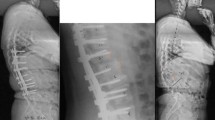Abstract
Study Design
Retrospective comparative study.
Objectives
To compare correction rates and complications of revision versus primary patients undergoing vertebral column resection (VCR).
Summary of Background Data
Although an all-posterior VCR has obviated the need for a circumferential approach, it is technically demanding, especially in a revision setting.
Methods
Between 2002 and 2009, 55 revision patients underwent a posterior-only VCR. Diagnoses included severe scoliosis (n = 3), kyphoscoliosis (KS) (n = 29), global kyphosis (GK) (n = 13), and angular kyphosis (AK) (n = 10). Radiographic findings and complications were compared with 38 primary patients who underwent a VCR during the same period. All patients had a minimum 2-year follow-up (range, 2—6 years).
Results
The mean number of VCR levels were 1.6 in revision versus 1.2 in primary cases (p =.005). In the severe scoliosis and KS groups, major coronal curve correction was 48% in revision versus 63% in primary cases (p =.001). In the KS, GK, and AK groups, the major sagittal curve correction was 52% in revision versus 57% in primary cases (p =.27). Preoperative (p =.015) and postoperative (p =.002) sagittal imbalance was significantly greater in the revision group. There were no spinal cord—related complications, but 7 revision (13%) and 3 primary (8%) patients temporarily lost neuromonitoring data or failed wakeup tests; however, none had a permanent neurological deficit. Six revision patients (11%) required further revision surgery due to implant failure (3), progressive sagittal or coronal imbalance (2), and delayed deep wound infection (1) versus only 1 primary patient (3%) due to increased coronal imbalance. Preoperative and postoperative Scoliosis Research Society scores were not significantly different between groups.
Conclusions
Vertebral column resections in revision patients may be more technically demanding than in primary patients but can be performed safely in conjunction with intraoperative spinal cord monitoring. Revision and primary patients undergoing a VCR showed improved clinical outcomes.
Similar content being viewed by others
References
Dick J, Boachie-Adjei O, Wilson M. One-stage versus two-stage anterior and posterior spinal reconstruction in adults: comparison of outcomes including nutritional status, complications rates, hospital costs, and other factors. Spine (Phila Pa 1976) 1992;17:S310–6.
Leatherman KD, Dickson RA. Two-stage corrective surgery for congenital deformities of the spine. J Bone Joint Surg Br 1979;61:324–8.
Boachie-Adjei O, Bradford DS. Vertebral column resection and arthrodesis for complex spinal deformities. J Spinal Disord 1991;4:193–202.
Bradford DS, Tribus CB. Vertebral column resection for the treatment of rigid coronal decompensation. Spine (Phila Pa 1976) 1997;22:1590–9.
Lenke LG, O’Leary PT, Bridwell KH, et al. Posterior vertebral column resection for severe pediatric deformity: minimum two-year follow-up of thirty-five consecutive patients. Spine (Phila Pa 1976) 2009;34:2213–21.
Lenke LG, Sides BA, Koester LA, et al. Vertebral column resection for the treatment of severe spinal deformity. Clin Orthop Relat Res 2010;468:687–99.
Suk SI, Kim JH, Kim WJ, et al. Posterior vertebral column resection for severe spinal deformities. Spine (Phila Pa 1976) 2002;27:2374–82.
Suk SI, Chung ER, Kim JH, et al. Posterior vertebral column resection for severe rigid deformities. Spine (Phila Pa 1976) 2005;30:1682–7.
Xie J, Wang Y, Zhao Z, et al. Posterior vertebral column resection for correction of rigid spinal deformity curves greater than 100°. J Neurosurg Spine 2012;17:540–51.
Mizutani J, Matsubara T, Fukuoka M, et al. Application of full-scale three-dimensional models in patients with rheumatoid cervical spine. Eur Spine J 2008;17:644–9.
Yamazaki M, Okawa A, Akazawa T, et al. Usefulness of 3-dimensional full-scale modeling for preoperative simulation of surgery in a patient with old unilateral cervical fracture-dislocation. Spine (Phila Pa 1976) 2007;32:E532–6.
Takeshita K, Lenke LG, Bridwell KH, et al. Analysis of patients with nonambulatory neuromuscular scoliosis surgically treated to the pelvis with intraoperative halo-femoral traction. Spine (Phila Pa 1976) 2006;31:2381–5.
Park DK, Braaksma B, Hammerberg KW, et al. The efficacy of preoperative halo-gravity traction in pediatric spinal deformity the effect of traction duration. J Spinal Disord Tech 2013;26:146–54.
Garabekyan T, Hosseinzadeh P, Iwinski HJ, et al. The results of preoperative halo-gravity traction in children with severe spinal deformity. J Pediatr Orthop B 2014;23:1–5.
Lieberman JA, Lyon R, Feiner J, et al. The efficacy of motor evoked potentials in fixed sagittal imbalance deformity correction surgery. Spine (Phila Pa 1976) 2008;33:E414–24.
Quraishi NA, Lewis SJ, Kelleher MO, et al. Intraoperative multimodality monitoring in adult spinal deformity: analysis of a prospective series of one hundred two cases with independent evaluation. Spine (Phila Pa 1976) 2009;34:1504–12.
Malhotra NR, Shaffrey CI. Intraoperative electrophysiological monitoring in spine surgery. Spine (Phila Pa 1976) 2010;35:2167–79.
Pastorelli F, Di Silvestre M, Plasmati R, et al. The prevention of neural complications in the surgical treatment of scoliosis: the role of the neurophysiological intraoperative monitoring. Eur Spine J 2011;20:S105–14.
Feng B, Qiu G, Shen J, et al. Impact of multimodal intraoperative monitoring during surgery for spine deformity and potential risk factors for neurological monitoring changes. J Spinal Disord Tech 2012;25:E108–14.
Author information
Authors and Affiliations
Corresponding author
Additional information
Author disclosures: YO (none); LGL (patents with Medtronic [unpaid]; consultant for DePuy Synthes Spine, K2M, Medtronic [monies donated to a charitable foundation]; royalties from Medtronic and modest royalties from Quality Medical Publishing; reimbursement related to meetings/-courses from AOSpine, BroadWater, DePuy Synthes Spine, K2M, Medtronic, Scoliosis Research Society, Seattle Science Foundation, Stryker Spine, Spinal Research Foundation); LK (none); KT (none).
Rights and permissions
About this article
Cite this article
Oshima, Y., Lenke, L.G., Koester, L. et al. Revision Versus Primary Patients Undergoing Vertebral Column Resection for Severe Spinal Deformities. Spine Deform 2, 350–357 (2014). https://doi.org/10.1016/j.jspd.2014.06.001
Received:
Revised:
Accepted:
Published:
Issue Date:
DOI: https://doi.org/10.1016/j.jspd.2014.06.001




